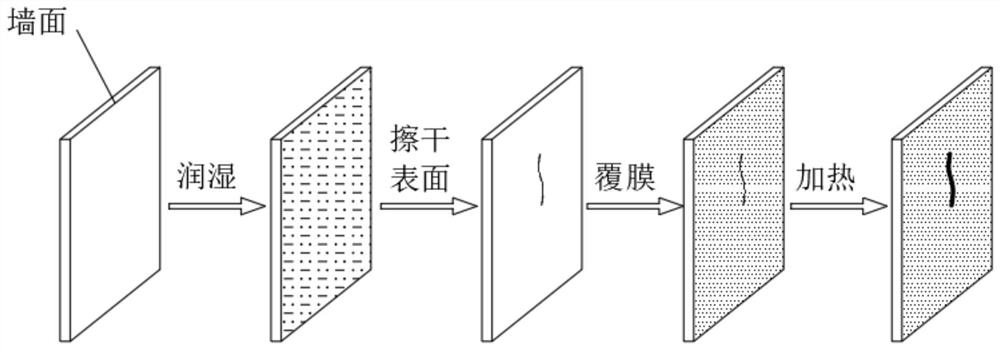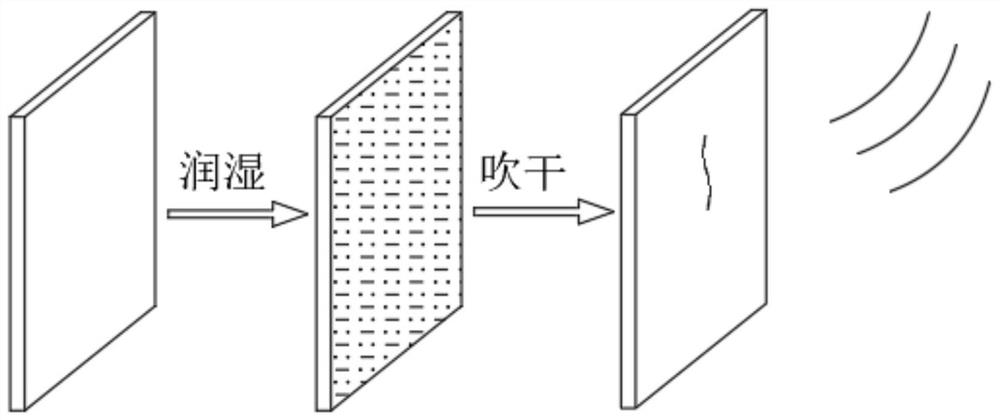Wall surface water seepage detection method for real estate building
A detection method and technology for construction, applied in measurement devices, permeability/surface area analysis, suspension and porous material analysis, etc., can solve problems such as poor water seepage detection, shortened building service life, and corroded wall strength. , to improve the efficiency and effect of water seepage detection, accurate positioning, and easy waterproof treatment.
- Summary
- Abstract
- Description
- Claims
- Application Information
AI Technical Summary
Problems solved by technology
Method used
Image
Examples
Embodiment 1
[0047] see figure 1 , a method for detecting water seepage on a wall surface of a real estate building, comprising the following steps:
[0048] S1. Clean the wall to be detected, then spray the detection liquid to wet the wall, and wipe off the liquid on the surface;
[0049] S2. Carry out film covering treatment on the wall surface to keep the film covering flat and fit without bulging;
[0050] S3. Heat the wall evenly as a whole, and observe whether there is a bulge in the coating. If there is a bulge, there is water seepage in the area. If there is no bulge, there is no water seepage area on the wall;
[0051] S4. Uncover the covering film and perform waterproof treatment on the seepage area.
[0052] see figure 2 , In the prior art, there is a method of spraying water for wetting and blowing dry for detection, but the method of blowing dry is easy to cause interference to the permeated water, and secondly, the effect of the permeated water is not obvious enough to be...
Embodiment 2
[0057] see Figure 4 In step S2, the coating adopts the detection film layer 1, and the detection film layer 1 includes a plurality of detection units.
[0058] see Figure 5-7 , the outer tympanic membrane 11 and the inner osmotic membrane 12 are symmetrically distributed, and the air barrier membrane 13 is surrounded and connected between the outer tympanic membrane 11 and the inner osmotic membrane 12, the detection ball 14 is connected to the inner surface of the inner osmotic membrane 12, and the deformation rod 15 is connected between the outer gas membrane 11 and the detection ball 14. When the detection liquid is heated and releases gas, the gas passes through the inner osmosis membrane 12 and enters the inner space to inflate continuously, and then forces the outer gas membrane 11 to expand and bulge. Furthermore, the detection ball 14 is pulled by the deformation rod 15 to release the functional material liquid 143 to mark or repair the seepage area.
[0059] see ...
PUM
 Login to View More
Login to View More Abstract
Description
Claims
Application Information
 Login to View More
Login to View More - R&D
- Intellectual Property
- Life Sciences
- Materials
- Tech Scout
- Unparalleled Data Quality
- Higher Quality Content
- 60% Fewer Hallucinations
Browse by: Latest US Patents, China's latest patents, Technical Efficacy Thesaurus, Application Domain, Technology Topic, Popular Technical Reports.
© 2025 PatSnap. All rights reserved.Legal|Privacy policy|Modern Slavery Act Transparency Statement|Sitemap|About US| Contact US: help@patsnap.com



